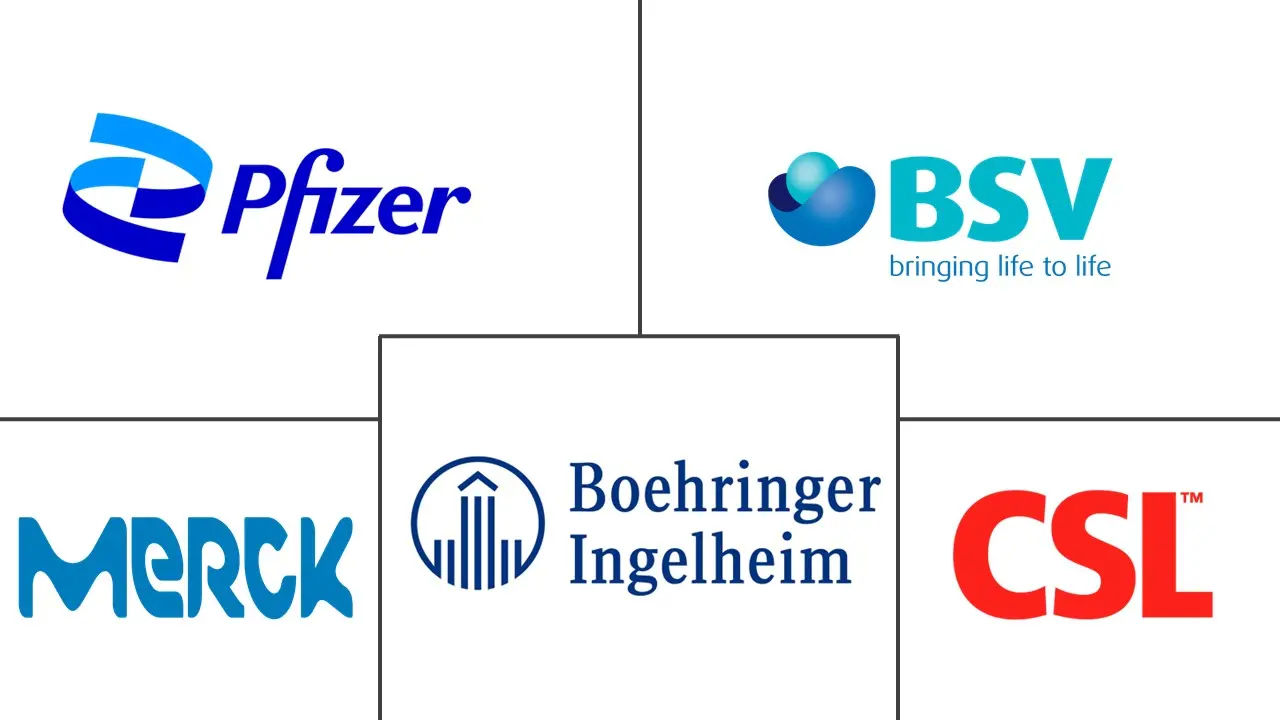Anti-venom Market Size and Share
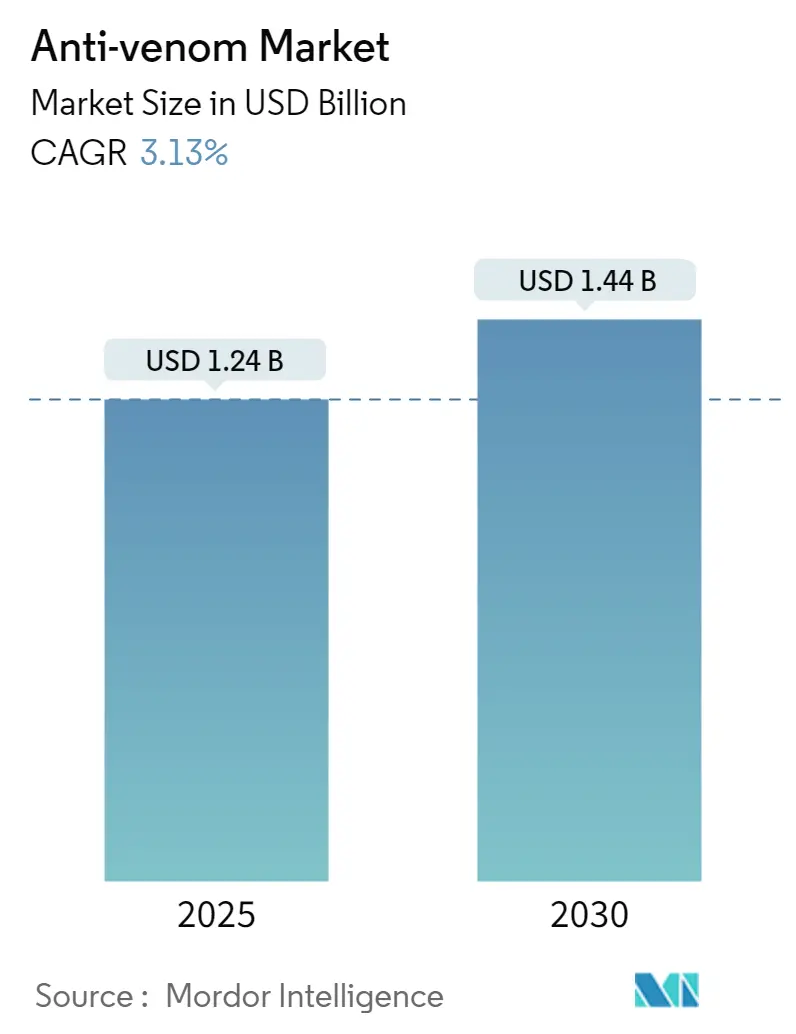
Anti-venom Market Analysis by Mordor Intelligence
The antivenoms market size stood at USD 1.24 billion in 2025 and is forecast to reach USD 1.44 billion by 2030, translating into a 3.13% CAGR over the period. Rising recognition of snakebite envenoming as a neglected tropical disease, coupled with expanding rural health infrastructure and accelerated regulatory pathways, underpins steady demand growth. Universal antivenom research, cost-saving recombinant platforms, and government stockpiling programs are broadening commercial opportunities even though overall production remains concentrated among six qualified manufacturers. Sub-Saharan Africa’s severe treatment gap, India’s high disease burden despite domestic production leadership, and North America’s elevated treatment costs continue to shape regional procurement strategies. Moderate competitive intensity stems from high regulatory barriers and specialized equine plasma processing, yet recombinant innovation is expected to lower entry hurdles and improve global supply security.
Key Report Takeaways
By product type, polyvalent formulations captured 55.64% of antivenoms market share in 2024, Recombinant antivenoms are projected to expand at a 3.26% CAGR through 2030.
By source, equine-derived products held 81.68% of the antivenoms market in 2024, while recombinant DNA and monoclonal platforms are the fastest-growing category at a 3.26% CAGR through 2030.
By end-user, hospitals accounted for 72.75% of the antivenoms market size in 2024, Clinics and trauma centers are advancing at a 3.91% CAGR between 2025 and 2030.
By geography, North America led with 42.03% antivenoms market share in 2024, Asia-Pacific is forecast to record the highest regional CAGR at 4.14% through 2030.
Global Anti-venom Market Trends and Insights
Driver Impact Analysis
| Driver | (~) % Impact on CAGR Forecast | Geographic Relevance | Impact Timeline |
|---|---|---|---|
| Expansion of rural emergency-care infrastructure | +0.8% | Asia-Pacific, Sub-Saharan Africa, Latin America | Medium term (2-4 years) |
| Rising governmental stock-piling programs in endemic nations | +0.6% | India, Brazil, Nigeria, Global endemic regions | Short term (≤ 2 years) |
| WHO pre-qualification accelerating international tenders | +0.4% | Global, with focus on Sub-Saharan Africa | Medium term (2-4 years) |
| Recombinant antivenom R&D cost declines | +0.5% | North America, Europe, Asia-Pacific | Long term (≥ 4 years) |
| Crowdsourced herpetofauna reporting apps improving demand visibility | +0.2% | Global, particularly rural endemic areas | Short term (≤ 2 years) |
| Source: Mordor Intelligence | |||
Expansion of Rural Emergency-Care Infrastructure
Governments are upgrading rural facilities so patients reach treatment inside the critical six-hour window, a change most evident in Asia-Pacific where agriculture-linked bite incidence peaks during harvest seasons. Brazil’s decentralized model supplies antivenom to nearly 3,000 municipalities and directly links funding to patient throughput, demonstrating that last-mile logistics translate into higher vial utilization rates. Bangladesh’s hub-and-spoke network cut transfer delays and reduced out-of-pocket costs, validating that regional venom centers improve equity for low-income communities.
Rising Governmental Stock-Piling Programs in Endemic Nations
India now targets 3–4 million vials per year, more than double current output, under its 2024 National Action Plan, signaling large forward contracts for local producers. Australia’s partnership with Papua New Guinea supplies 600 vials annually and has saved 2,000+ lives since 2018, illustrating the life-saving impact of bilateral aid channels. Military buyers such as the U.S. Army add niche but high-value demand segments that require rapid stock rotation and stringent potency testing.
WHO Pre-Qualification Accelerating International Tenders
The March 2024 introduction of parallel recommendation and regulatory pathways compresses dossier review to 12 months, enabling faster tender participation for new entrants[1]Source: World Health Organization, “Addressing Antivenoms Issues,” WHO.INT . Only three antivenoms presently carry WHO approval for Sub-Saharan Africa, so additional certifications could unlock multi-year purchase agreements financed through global health funds. Manufacturers benefit from predictable demand and risk-sharing mechanisms that stabilize cash flow despite narrow gross margins.
Recombinant Antivenom R&D Cost Declines
Deep-learning protein design at University of Washington cuts material costs from USD 2,000 to USD 100 per treatment, supporting broader commercial feasibility. Human monoclonal antibody cocktails demonstrated full protection against 13 species in murine models, confirming the platform's cross-species utility. Scale-up partnerships between public research institutes and contract biologics manufacturers are expected to move first-in-class recombinant products into pivotal trials by 2027.
Restraint Impact Analysis
| Restraint | (~) % Impact on CAGR Forecast | Geographic Relevance | Impact Timeline |
|---|---|---|---|
| Cold-chain gaps in tropical regions | -0.7% | Sub-Saharan Africa, Southeast Asia, Amazon Basin | Medium term (2-4 years) |
| Highly variable venom composition limiting cross-neutralisation | -0.5% | Global, particularly Asia-Pacific diverse ecosystems | Long term (≥ 4 years) |
| Fluctuating equine plasma supply | -0.3% | Global manufacturing centers | Short term (≤ 2 years) |
| Source: Mordor Intelligence | |||
Cold-Chain Gaps in Tropical Regions
Liquid antivenoms require 2–8 °C storage yet many endemic districts lack grid-reliable cold rooms. Freeze-dried formats stabilized with sucrose preserved potency after three weeks at 45 °C, indicating a workable mitigation pathway. Extended shelf-life evidence from African polyvalent products suggests regulators could re-evaluate expiration dating to reduce preventable stockouts. Still, physical distribution remains challenging in the Amazon basin where river transport and seasonal flooding interrupt supply chains for months.
Highly Variable Venom Composition Limiting Cross-Neutralization
Geographic venom diversity undermines polyvalent coverage, as demonstrated in Mexico where certain viperid venoms escape neutralization by national products. India’s “Big Four” focus leaves northeastern pit viper cases undertreated, elevating morbidity risk. Research into broadly neutralizing antibodies aims to bridge these gaps by targeting conserved toxin epitopes, yet regulatory pathways must adapt to multivalent biologics.
Segment Analysis
By Product Type: Polyvalent Dominance Drives Broad-Spectrum Demand
Polyvalent formulations commanded 55.64% of the antivenoms market share in 2024 owing to their multi-species coverage in scenarios where rapid species identification is not feasible. In rural hospitals, stocking a single polyvalent vial simplifies inventory and lowers training requirements for frontline staff. The antivenoms market size for polyvalent products is forecast to expand modestly as government tenders continue to favor broad-spectrum solutions for cost efficiency.
Recombinant antivenoms, although a nascent category, are moving from proof-of-concept to Phase I/II trials at a 3.26% CAGR. Lower immunogenicity, consistent batch quality, and scalable cell-culture production underpin interest from both regulators and donors. The segment’s success hinges on demonstrating equivalent or superior neutralization breadth compared with equine-derived polyvalents while delivering meaningful cost reductions.
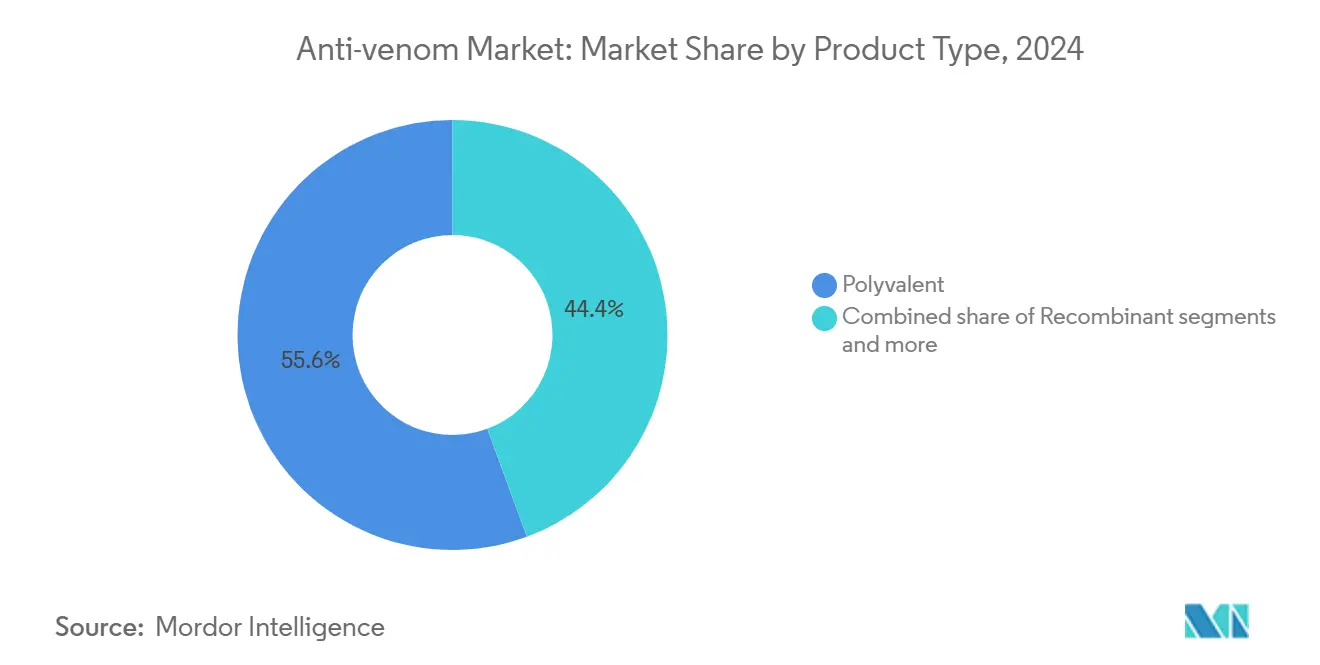
Note: Segment shares of all individual segments available upon report purchase
By Source: Equine-Derived Leadership Faces Recombinant Innovation
Equine-based products retained 81.68% share of the antivenoms market size in 2024 as century-old hyper-immunization protocols offer proven yields and well-established regulatory dossiers. Horses generate high-titer antibodies across diverse venoms, supporting cost-effective bulk production. Supply volatility remains a risk because plasma output depends on herd health and biosecurity controls.
Ovine-derived Fab and F(ab’)2 fragments cater to North American and European applications, where shorter half-life fragments align with intensive care resources and insurance reimbursement structures. Recombinant and monoclonal platforms, though currently under 1% market share, present the fastest growth trajectory by circumventing biological variability. A successful technology transfer to large-scale bioreactors would enable geographically agnostic manufacturing hubs, minimizing cold-chain exposure in tropical settings.
By End-User: Hospital Dominance Supports Specialized Treatment Infrastructure
Hospitals absorbed 72.75% of the antivenoms market size in 2024 because severe envenomation requires ventilators, dialysis, and polyvalent dosing protocols only available in higher-tier facilities. Multi-disciplinary teams oversee hemodynamic monitoring and treat anaphylaxis risk during infusion. This centralization drives the antivenoms market toward relatively stable institutional buyers that negotiate long-term supply contracts.
Clinics and trauma centers are expected to expand access at a 3.91% CAGR, aided by national programs that subsidize vial costs and fund staff training. Decentralized stock models improve time to first dose, particularly for neurotoxic bites where delay translates into respiratory failure. Military and occupational health buyers form a small yet consistent niche focused on mission-critical readiness against rare but potentially fatal exposures.
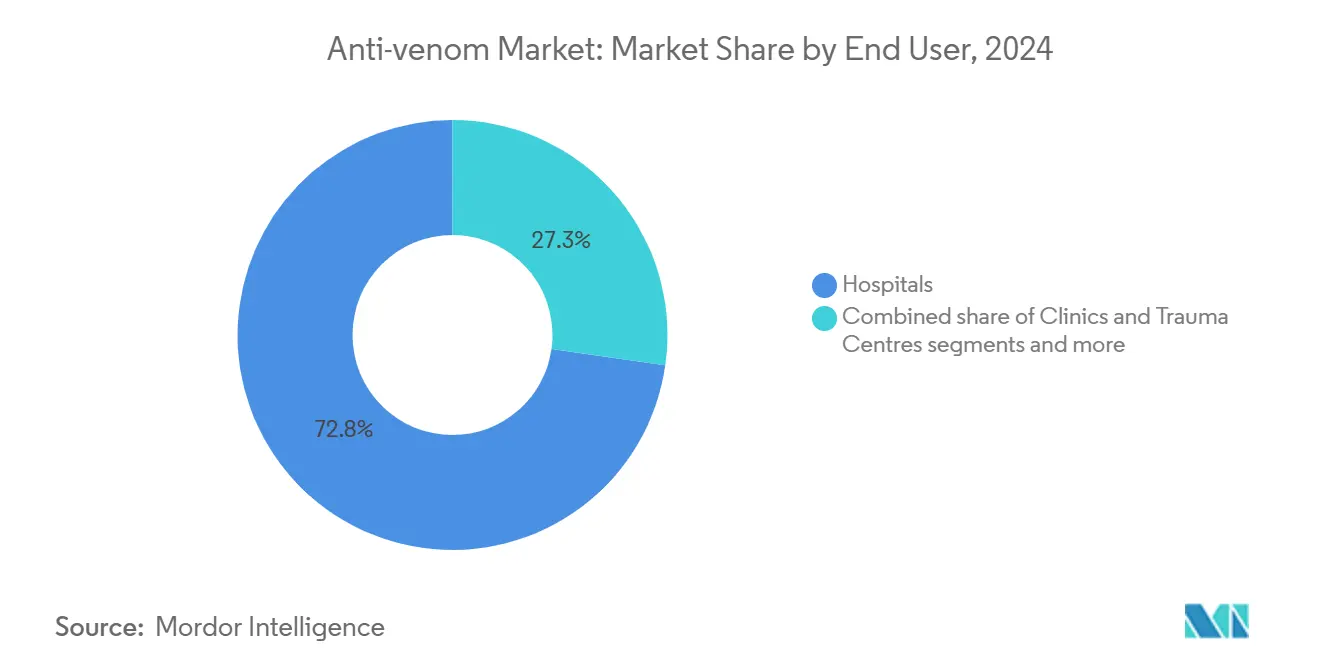
Note: Segment shares of all individual segments available upon report purchase
Geography Analysis
North America retained a 42.03% share of the antivenoms market in 2024, largely due to USD 31,343 median treatment costs that inflate overall revenue despite lower case counts. Poison control networks, helicopter evacuation, and payer coverage support high utilization rates. Rural pediatric patients receive antivenom more frequently than urban cohorts, signaling differential resource allocation that sustains demand.
Asia-Pacific is the fastest-growing region at a 4.14% CAGR to 2030 as India, China, and Bangladesh expand rural trauma centers, adopt tele-consultation, and roll out digital surveillance tools. India’s National Action Plan earmarks funding for regional venom repositories and standardized training curricula, while Japan’s biotech sector invests in recombinant antibody pipelines that could supply regional markets. The antivenoms market size in Asia-Pacific is therefore expected to approach USD 475 million by 2030, assuming current reimbursement frameworks remain intact.
Europe maintains a stable demand base dominated by veterinary and exotic pet sectors. Import licenses require rigorous lot-release testing, lengthening lead times and favoring domestic stock manufacturing for critical inventory. South America benefits from Brazil’s Instituto Butantan, which fulfills 100% national demand and exports surplus to neighboring countries. The Middle East and Africa continue to face severe shortfalls; Sub-Saharan Africa accesses only 2.5% of required treatments, underscoring the urgency of WHO-led financing mechanisms.
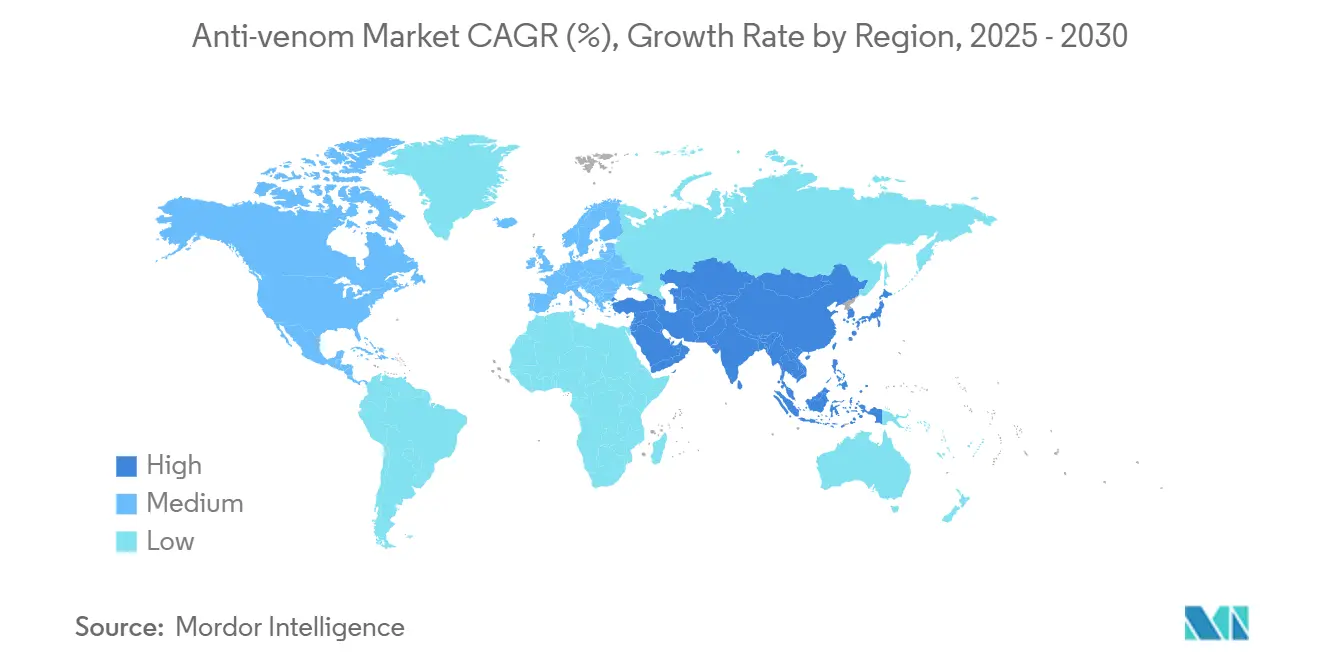
Competitive Landscape
Six major producers dominate the antivenoms market, resulting in moderate concentration driven by specialized equine husbandry, sophisticated downstream purification, and multistage regulatory dossiers. Instituto Butantan, CSL Seqirus, Vins Bioproducts, Bharat Serums & Vaccines, Laboratorios Bioclon, and Rare Disease Therapeutics collectively anchor global capacity. Entry barriers include validated equine herds, GMP fractionation, and WHO pre-qualification audits, all of which require multi-year capital outlays.
Strategic differentiation centers on geographic licensing and regulatory status. Only three products hold WHO approval for Sub-Saharan Africa, positioning certified suppliers for sole-source tenders able to cover cross-border demand. Public-private partnerships are expanding; CSL Seqirus’ Papua New Guinea collaboration demonstrates that donor funding can underwrite low-margin volumes while maintaining quality.
Innovation races focus on universal monoclonal cocktails and AI-designed proteins that aim to neutralize multiple species at milligram dosages. Centivax reported broadly neutralizing antibodies against 19 species, while University of Washington’s synthetic scaffolds yielded triple-digit cost reductions in preclinical studies. Intellectual property protection around antibody sequences and formulation know-how is emerging as the primary competitive moat.
Anti-venom Industry Leaders
-
Pfizer Inc.
-
Merck KGaA (Sigma Aldrich)
-
Boehringer Ingelheim
-
CSL Limited
-
Bharat Serums and Vaccines Ltd
- *Disclaimer: Major Players sorted in no particular order



Recent Industry Developments
- April 2025: Brazil’s BNDES, Instituto Butantan, and Finep launched a R$ 200 million fund to bolster domestic biologics supply chains
- January 2025: University of Washington released AI-designed proteins neutralizing three-finger toxins at laboratory scale
Global Anti-venom Market Report Scope
As per the scope of the report, An anti-venom (or antivenin or antivenene) is a biological product used to treat venomous bites or stings. The anti-venom is created by extracting venom from the relevant species of animal, which includes snakes, spiders, insects, fish, etc. The Anti-venom Market is Segmented by Species (Snake, Scorpion, Spiders, and Other Species), Anti-venom Type (Polyvalent Anti-venoms, Monovalent Anti-venom, and Other Anti-venom Types), and Geography (North America, Europe, Asia-Pacific, Middle East and Africa, and South America). The market report also covers the estimated market sizes and trends for 17 countries across major regions globally. The report offers the market size and forecasts in value (USD million) for the above segments.
| Polyvalent |
| Monovalent |
| Others |
| Equine-derived |
| Ovine-derived |
| Recombinant (DNA/Monoclonal) |
| Hospitals |
| Clinics & Trauma Centres |
| Military & Special-Purpose |
| North America | United States |
| Canada | |
| Mexico | |
| Europe | Germany |
| United Kingdom | |
| France | |
| Italy | |
| Spain | |
| Rest of Europe | |
| Asia-Pacific | China |
| India | |
| Japan | |
| South Korea | |
| Australia | |
| Rest of Asia-Pacific | |
| South America | Brazil |
| Argentina | |
| Rest of South America | |
| Middle East and Africa | GCC |
| South Africa | |
| Rest of Middle East and Africa |
| By Product Type | Polyvalent | |
| Monovalent | ||
| Others | ||
| By Source | Equine-derived | |
| Ovine-derived | ||
| Recombinant (DNA/Monoclonal) | ||
| By End-User | Hospitals | |
| Clinics & Trauma Centres | ||
| Military & Special-Purpose | ||
| By Geography | North America | United States |
| Canada | ||
| Mexico | ||
| Europe | Germany | |
| United Kingdom | ||
| France | ||
| Italy | ||
| Spain | ||
| Rest of Europe | ||
| Asia-Pacific | China | |
| India | ||
| Japan | ||
| South Korea | ||
| Australia | ||
| Rest of Asia-Pacific | ||
| South America | Brazil | |
| Argentina | ||
| Rest of South America | ||
| Middle East and Africa | GCC | |
| South Africa | ||
| Rest of Middle East and Africa | ||


Key Questions Answered in the Report
How large is the antivenoms market in 2025 and what growth rate is expected?
The antivenoms market size reached USD 1.24 billion in 2025 and is projected to rise to USD 1.44 billion by 2030, implying a 3.13% CAGR.
Which product category holds the greatest share?
Polyvalent formulations led with 55.64% antivenoms market share in 2024.
Which region is forecast to grow the fastest through 2030?
Asia-Pacific is projected to register the highest regional CAGR at 4.14% thanks to rural healthcare expansion and government stockpiling.
What technological trend could lower antivenom costs?
Recombinant and AI-designed antibody platforms aim to cut per-treatment costs from USD 2,000 to roughly USD 100 once scaled.
Why is WHO pre-qualification important for suppliers?
WHO pre-qualification enables participation in international tenders and serves as a quality benchmark in endemic regions that lack strong national regulatory agencies.
Page last updated on:
